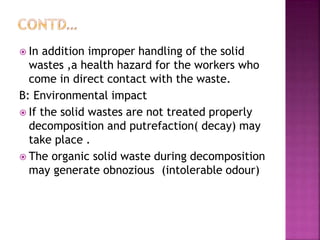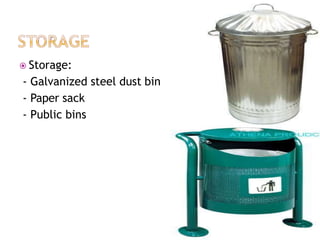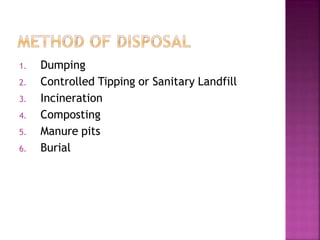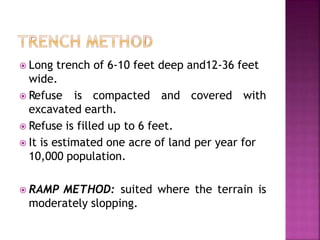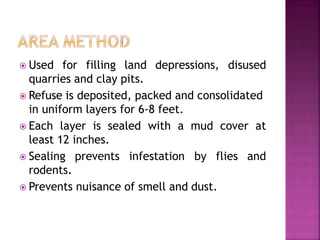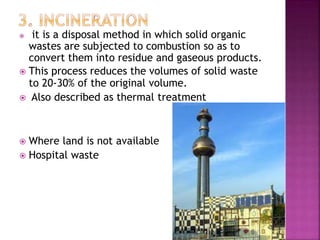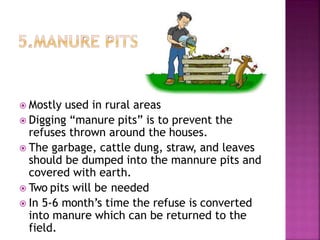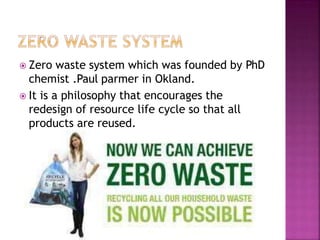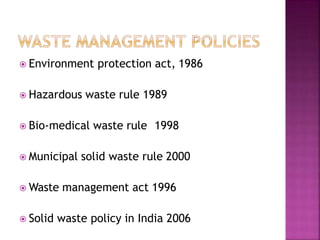Solid waste management
- 2. Introduction to waste and types Solid waste Types of solid waste Effects of solid waste Waste management concept Concept of 3R solid waste management storage collection waste handling and transport method of disposal Technology Zero waste system Recommendation
- 3. It is defined as Waste (also known as rubbish, trash, refuse, garbage, junk) is any unwanted or useless materials. OR Any materials unused and rejected as worthless or unwanted and “A useless or profile less activity using or expanding or consuming thoughtlessly or carefully.”
- 4. Solid waste Liquid waste Gaseous waste Animal by product(ABPs) Biodegradable waste Chemical waste Commercial waste/ Business waste Biomedical waste Bulky waste
- 5. It is defined as “ non liquid, non-soluble materials ranging from municipal garbage to industrial wastes that contain complex & sometimes hazardous substances” Solid waste also include Garbage Rubbish Demolition products Sewage treatment residue Dead animals Manure and other discarded material. -- Per capita solid waste out put 0.25-2.5 Kg/day
- 6. Street refuse Market refuse Stable litter Industrial refuse Domestic refuse
- 7. In addition improper handling of the solid wastes ,a health hazard for the workers who come in direct contact with the waste. B: Environmental impact If the solid wastes are not treated properly decomposition and putrefaction( decay) may take place . The organic solid waste during decomposition may generate obnozious (intolerable odour)
- 8. The 3Rs (Reduce, Reuse, Recycle) to be followed for waste management.
- 9. Waste management is the storage collection transport and handling recycling disposal and monitoring of waste materials.
- 10. Storage: - Galvanized steel dust bin - Paper sack - Public bins
- 11. Collection - House-to-house collection - Collection from the public bins
- 12. Waste handling and separation involves activities associated with waste management until the waste is placed in storage containers for collection. Handling also encompasses the movement of loaded containers to the point of collection. waste is transferred from a smaller collection vehicle to larger transport equipment
- 13. Recycling refers to the collection and refuse of waste materials such as empty beverage container. The materials from which the items are made can be processed into new products. Materials for recycling may be collected separately from general waste using dedicated bins.
- 14. 1. Dumping 2. Controlled Tipping or Sanitary Landfill 3. Incineration 4. Composting 5. Manure pits 6. Burial
- 15. Public hygiene and health. Reuse, recovery and recycle Energy generation Sustainable development Aesthetics
- 16. Low lying areas. Mainly for dry refuses Kolkata disposes by this method and reclaimed land given for cultivation. Unsanitary method - Exposed to flies and rodents - Nuisance - Dispersed by wind - pollution of surface water
- 17. Satisfactory method - Material placed in a trench -compacted with earth at the end of the working day. Modified sanitary land fill-where compaction and covering are accomplished once or twice a week.
- 18. 3 Methods 1. Trench method 2. Ramp method 3. Area method Refuse is compacted on its exposed surface with excavated earth (30 cm).
- 19. Long trench of 6-10 feet deep and12-36 feet wide. Refuse is compacted and covered with excavated earth. Refuse is filled up to 6 feet. It is estimated one acre of land per year for 10,000 population. RAMP METHOD: suited where the terrain is moderately slopping.
- 20. Used for filling land depressions, disused quarries and clay pits. Refuse is deposited, packed and consolidated in uniform layers for 6-8 feet. Each layer is sealed with a mud cover at least 12 inches. Sealing prevents infestation by flies and rodents. Prevents nuisance of smell and dust.
- 21. Changes - Chemical - Bacteriological - Physical The temperature rises to over 60 deg. C within 7 days and kills all pathogens and hastens the decomposition process. It takes 4 to 6 months for complete decomposition.
- 22. it is a disposal method in which solid organic wastes are subjected to combustion so as to convert them into residue and gaseous products. This process reduces the volumes of solid waste to 20-30% of the original volume. Also described as thermal treatment Where land is not available Hospital waste
- 23. Method of combined disposal of refuse and night soil/ sludge Principal by products are: CO2 , Water and heat End product- compost Methods a. Bangalore method b. Mechanical composting c. Vermicomposting
- 25. IISc- Indian Council of Agricultural Research. Trenches are dug 3ft (90cm)deep, 5-8ft broad, 15-30ft long. Composting procedure - 1. Layer of Refuse- 15 cm - 2. Layer of Night soil – 5 cm Till heap rises 30cms above ground level. Physical, chemical and biological changes takes place Not recomended for a population over 1lakh
- 26. Compost manufactured by processing raw materials. 1. Screening (remove rug, sack, bone etc) 2. Pulverization (<2inches) 3. Mixing 4. Incubation (CN ration, temp, moisture,pH, aeration) Process completed in 4-6 week C: vermicomposting :It is a method of disposal of kitchen and plate wastes, which serves the dual purpose of disposing off the garbage as well as proving eco-friendly.
- 27. Mostly used in rural areas Digging “manure pits” is to prevent the refuses thrown around the houses. The garbage, cattle dung, straw, and leaves should be dumped into the mannure pits and covered with earth. Two pits will be needed In 5-6 month’s time the refuse is converted into manure which can be returned to the field.
- 28. Suitable for small camp A trench 1.5m wide &2 m deep is excavated The refuse is covered with 20 -30cm of earth When the level in the trench is 40cm from ground level, the trench is filled with earth & compacted 4-6 months
- 29. Zero waste system which was founded by PhD chemist .Paul parmer in Okland. It is a philosophy that encourages the redesign of resource life cycle so that all products are reused.
- 30. Environment protection act, 1986 Hazardous waste rule 1989 Bio-medical waste rule 1998 Municipal solid waste rule 2000 Waste management act 1996 Solid waste policy in India 2006
- 31. The improvement of people and private sector through NGOs could improve the efficiency of solid waste management. Public awareness should be created especially at primary level. Littering of solid waste should prohibited in cities towns and urban areas. More over house to house collecting solid waste should be .
- 32. The collection bins must be have a large enough capacity to accommodate 20% more than the expected waste generation in the area. Municipal authorities should maintain the storage facilities to avoid unhygienic & unsanitary condition. It is advisable to move from open dumping to sanitary land filling in a phased manner.
Editor's Notes
- Street- leaves, straw, paper animal droping liiter Market- putrid veg animal drop Caco3 toxic and explosive material Ash,






